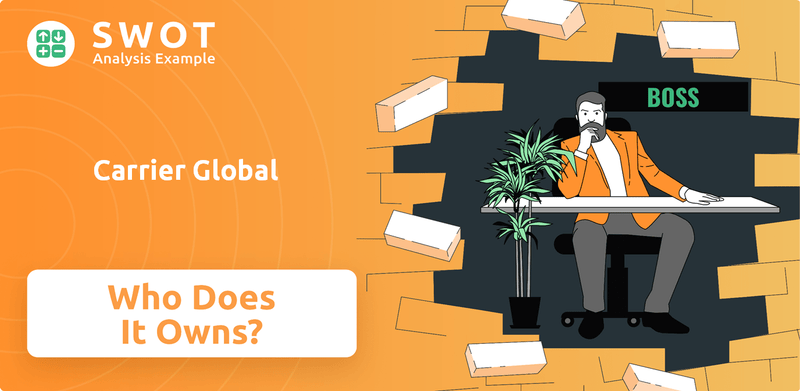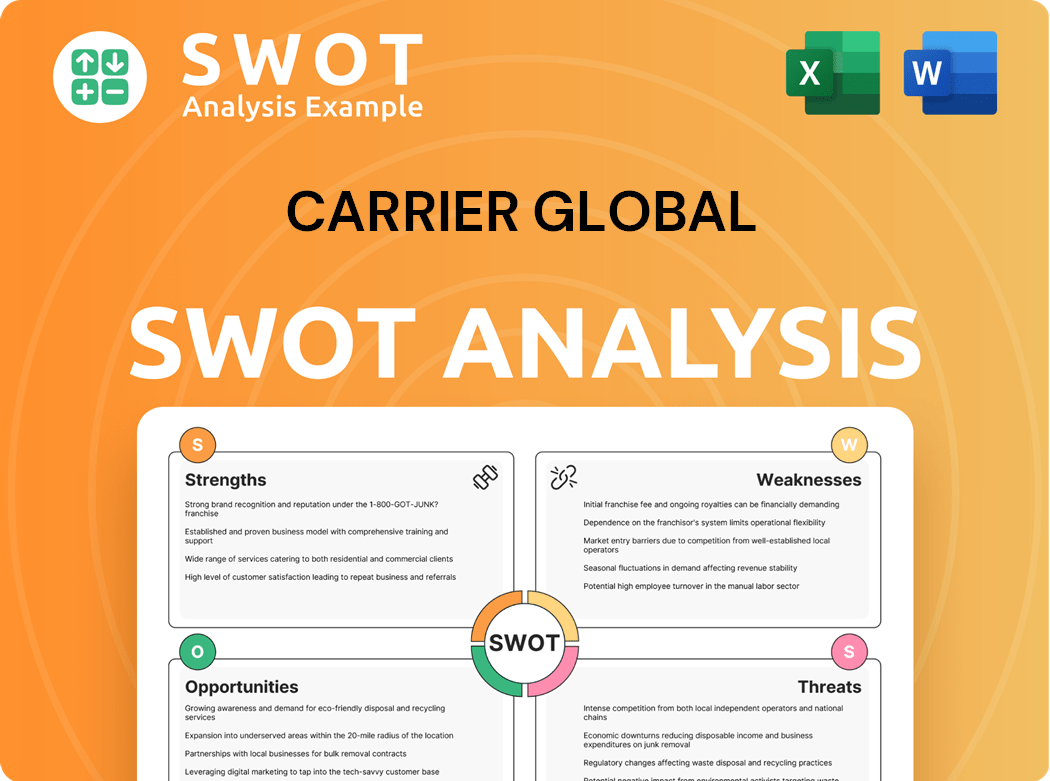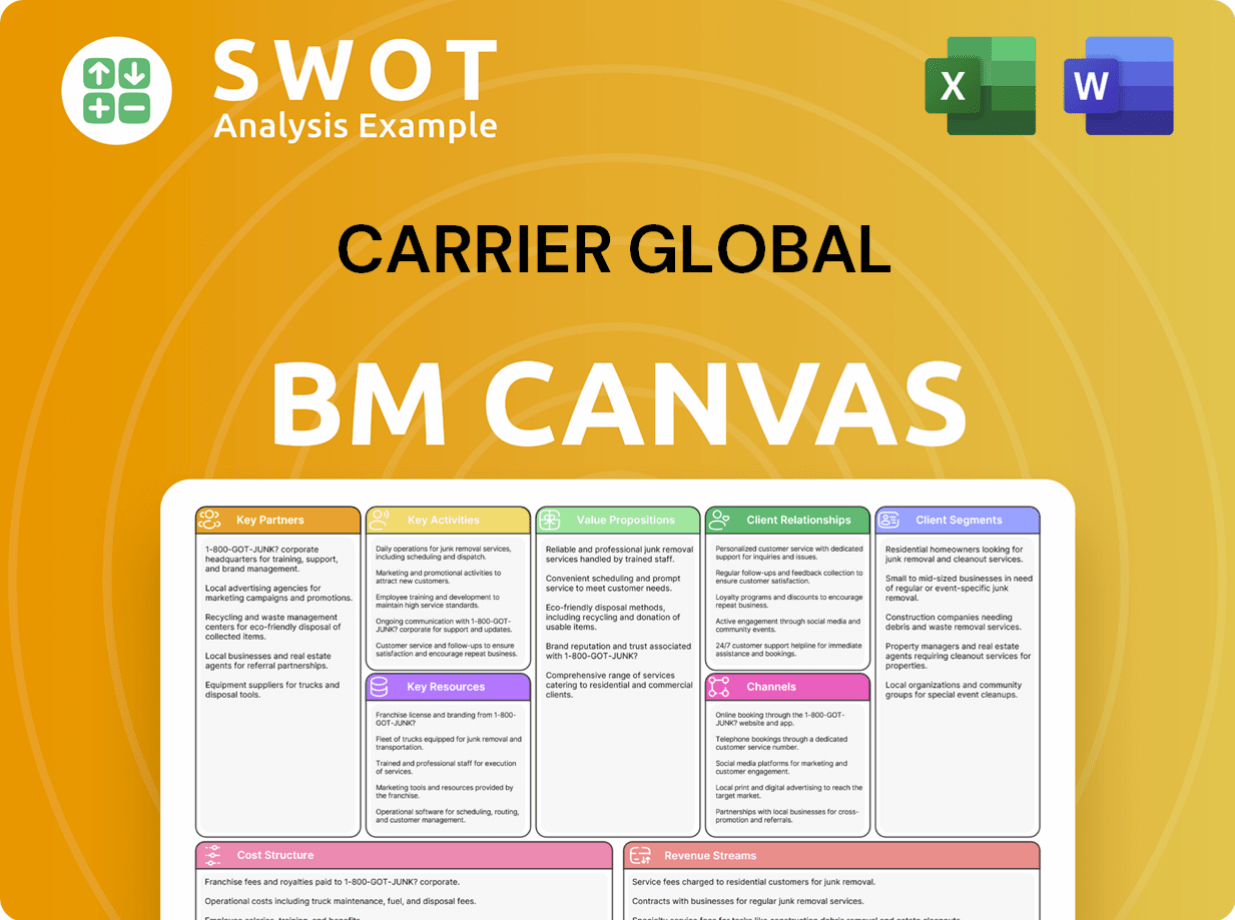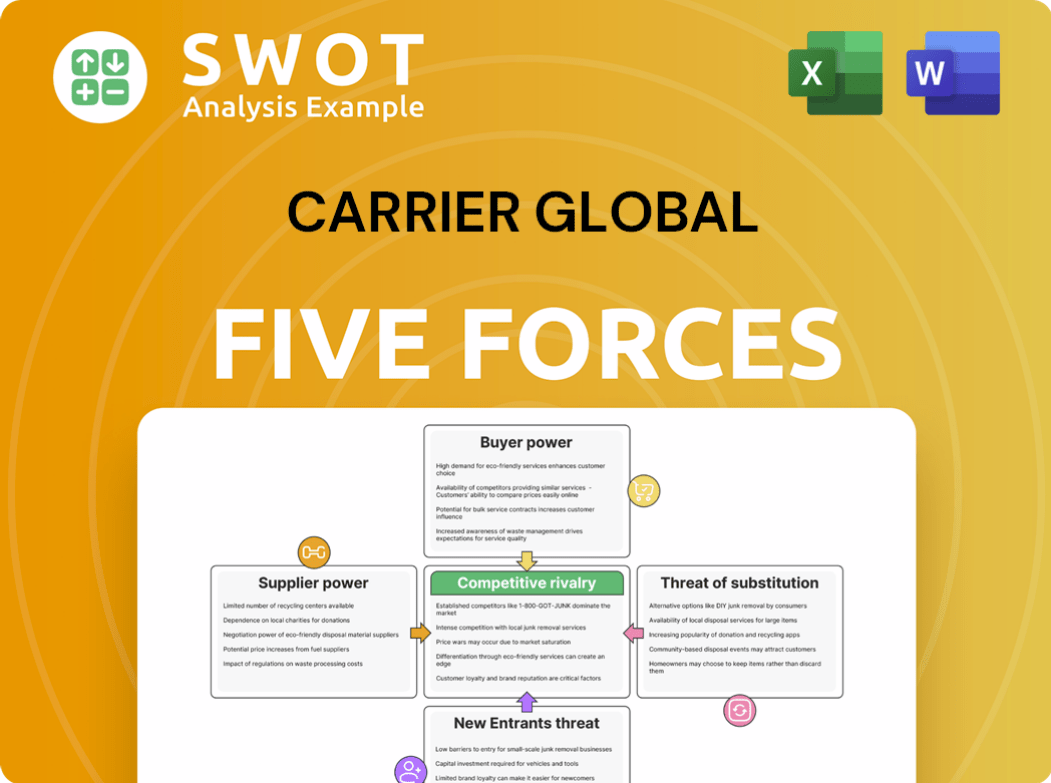Carrier Global Bundle
Who Really Controls Carrier Global?
Ever wondered who pulls the strings at Carrier Global, a global powerhouse in HVAC and building technologies? Understanding Carrier Global SWOT Analysis is crucial, but knowing its ownership structure is the key to unlocking its strategic direction and market potential. From its roots as Carrier Engineering Corporation to its current status, the evolution of Carrier's ownership tells a compelling story of growth and transformation.

This exploration into Carrier ownership will uncover the key players shaping Carrier Global's destiny. We will dissect the Carrier company's ownership structure, from major institutional investors to the influence of its board of directors. By understanding Who owns Carrier, we gain valuable insights into its Carrier Corporation strategy, financial performance, and its ability to innovate within the competitive Carrier HVAC market.
Who Founded Carrier Global?
The story of Carrier Global starts with Willis Carrier, who invented modern air conditioning in 1902. The company itself, initially known as Carrier Engineering Corporation, was officially founded in 1915. This marked the beginning of a significant player in the HVAC (heating, ventilation, and air conditioning) industry.
The founding of the Carrier company involved Willis Carrier and six other engineers. These individuals played a crucial role in shaping the company's early direction and technological advancements. While specific equity details from the company's inception aren't widely available in public records, the founders were key to its initial success.
Early ownership of Carrier was primarily held by the founders. They used their combined expertise to build the air conditioning industry. The company's ownership structure evolved over time, eventually leading to its acquisition by United Technologies Corporation (UTC) in 1979. This acquisition marked a shift from the original ownership, integrating Carrier into a larger entity.
The original founders of Carrier, including Willis Carrier, were the primary owners in the early years.
- The company was founded in 1915 by Willis Carrier and six other engineers.
- Early ownership was concentrated among these founders, who drove the company's initial growth.
- The 1979 acquisition by UTC changed the ownership structure significantly.
- No specific details about angel investors or significant early external investments are widely publicized.
Carrier Global SWOT Analysis
- Complete SWOT Breakdown
- Fully Customizable
- Editable in Excel & Word
- Professional Formatting
- Investor-Ready Format

How Has Carrier Global’s Ownership Changed Over Time?
The ownership structure of Carrier Global Corporation has seen a major shift, with the most significant change occurring on April 3, 2020. On this date, Carrier spun off from United Technologies Corporation (UTC) to become an independent, publicly traded company. This strategic move by UTC aimed to create focused entities and unlock shareholder value. The initial public offering (IPO) of Carrier reflected its established presence in the HVAC, refrigeration, fire, and security sectors.
Following the spin-off, Carrier's ownership transitioned primarily to institutional investors, mutual funds, index funds, and individual shareholders. This shift has significantly influenced Carrier's governance, subjecting strategic decisions to the scrutiny of a broad shareholder base and market dynamics. The company's performance, such as the 2024 full-year results with net sales of $22.2 billion, showcases its operational strength under this new ownership structure. This evolution marks a transition from being a subsidiary within a large conglomerate to an autonomous entity directly accountable to its diverse public and institutional shareholder base.
| Event | Date | Impact on Ownership |
|---|---|---|
| Spin-off from UTC | April 3, 2020 | Carrier became an independent, publicly traded company. |
| Initial Public Offering (IPO) | April 3, 2020 | Ownership shifted to institutional and individual investors. |
| Subsequent Market Activity | Ongoing | Ownership distribution among institutional investors, mutual funds, and individual shareholders. |
As of the first quarter of 2025, the largest shareholders of Carrier Global's target market often include institutional investors like Vanguard Group Inc. and BlackRock Inc., holding substantial percentages through their various funds. Other key institutional investors commonly include State Street Corporation, Capital Research Global Investors, and Fidelity Management & Research Company. These institutional holdings represent the collective investments of millions of individuals through retirement accounts and other investment vehicles. The shift highlights a transition from being a subsidiary within a large conglomerate to an autonomous entity directly accountable to its diverse public and institutional shareholder base.
Carrier Global's ownership structure has evolved significantly since its spin-off from UTC in 2020.
- The company is now primarily owned by institutional investors, mutual funds, and individual shareholders.
- The spin-off aimed to create focused entities and unlock shareholder value.
- Carrier's financial performance, such as the $22.2 billion in net sales in 2024, reflects its operational strength under the new ownership structure.
- The shift has impacted governance, with strategic decisions subject to shareholder and market influence.
Carrier Global PESTLE Analysis
- Covers All 6 PESTLE Categories
- No Research Needed – Save Hours of Work
- Built by Experts, Trusted by Consultants
- Instant Download, Ready to Use
- 100% Editable, Fully Customizable

Who Sits on Carrier Global’s Board?
The Board of Directors of Carrier Global Corporation oversees the company's operations, acting on behalf of its shareholders. As of early 2025, the board typically includes a mix of independent directors and individuals with extensive industry experience. The board's composition reflects the company's commitment to sound corporate governance, ensuring diverse perspectives and expertise guide strategic decisions. The board's structure and composition are crucial for maintaining investor confidence and driving long-term value.
The board does not typically have direct representation from major shareholders like Vanguard or BlackRock. Instead, these institutional investors influence decisions through their voting power on proposals and director elections. This structure allows for a balance between shareholder interests and the board's independent judgment. The board's responsibilities include overseeing the company's financial performance, setting strategic direction, and ensuring compliance with legal and regulatory requirements.
| Director Name | Title | Primary Affiliation |
|---|---|---|
| David Gitlin | Chairman and CEO | Carrier Global Corporation |
| Christopher Nelson | Lead Independent Director | Former Executive Vice President, United Technologies Corporation |
| Linda J. Sanford | Director | Former Senior Vice President, IBM |
The voting structure at Carrier Global Corporation generally follows a one-share-one-vote principle, common in publicly traded companies. Each share of common stock typically grants its holder one vote on shareholder matters, including director elections and executive compensation. There are no widely reported special voting rights or dual-class shares that would grant disproportionate control to any single entity. This structure ensures that voting power is directly proportional to share ownership, promoting fairness and transparency in corporate governance. The company's commitment to this voting structure is a key element of its investor relations strategy.
Understanding the ownership structure and board composition is vital for investors. The board's independence and the one-share-one-vote system are key aspects of Carrier Global's governance.
- The board includes independent directors and industry experts.
- Major institutional investors influence decisions through their voting power.
- The company operates under a standard governance framework.
- Learn more about the Growth Strategy of Carrier Global.
Carrier Global Business Model Canvas
- Complete 9-Block Business Model Canvas
- Effortlessly Communicate Your Business Strategy
- Investor-Ready BMC Format
- 100% Editable and Customizable
- Clear and Structured Layout

What Recent Changes Have Shaped Carrier Global’s Ownership Landscape?
Following its 2020 spin-off, the ownership profile of Carrier Global has continued to shift. A notable move was the December 2023 announcement of the sale of its Industrial Fire business to Sentinel Capital Partners for $1.425 billion. This divestiture, expected to conclude by the end of 2024, reflects Carrier's strategic focus on its core HVAC and intelligent building solutions. Such portfolio adjustments often influence shareholder composition as the company refines its strategic direction and reallocates capital.
Simultaneously, Carrier has been engaged in strategic acquisitions. The 2023 acquisition of Viessmann Climate Solutions for €12 billion significantly enhanced its presence in the European heating market. While acquisitions don't directly modify the existing share structure, they can attract new investors interested in the company's expanded market reach and growth prospects, potentially influencing the overall ownership mix. This is part of a broader strategy, as detailed in the Growth Strategy of Carrier Global.
| Year | Transaction | Impact on Ownership |
|---|---|---|
| 2023 | Acquisition of Viessmann Climate Solutions | Expanded market reach, potential for new investor interest |
| 2023 | Agreement to sell Industrial Fire business | Strategic portfolio optimization, potential shift in shareholder composition |
| Ongoing | Increased institutional ownership | More dispersed ownership base, with large institutional investors |
Industry trends also play a role. Increased institutional ownership is common in large-cap companies like Carrier, driven by the growth of passive investment vehicles. While founder dilution is less relevant for Carrier, sector consolidation could lead to future ownership changes. Carrier's leadership is committed to disciplined capital allocation, indicating further potential changes in its ownership landscape through future strategic moves.
Institutional investors often hold significant stakes in large-cap companies. This can lead to a more dispersed ownership structure. Passive investment vehicles, such as index funds, contribute to this trend.
Acquisitions like Viessmann Climate Solutions can attract new investors. These moves signal growth prospects and expanded market reach. They can indirectly influence the overall ownership mix.
Divestitures, such as the sale of the Industrial Fire business, are part of portfolio optimization. These actions can lead to shifts in shareholder composition. They reflect a strategic focus on core business areas.
Carrier's leadership is committed to disciplined capital allocation. This strategy may involve further divestitures or acquisitions. Such moves can indirectly influence the company's ownership landscape.
Carrier Global Porter's Five Forces Analysis
- Covers All 5 Competitive Forces in Detail
- Structured for Consultants, Students, and Founders
- 100% Editable in Microsoft Word & Excel
- Instant Digital Download – Use Immediately
- Compatible with Mac & PC – Fully Unlocked

Related Blogs
- What are Mission Vision & Core Values of Carrier Global Company?
- What is Competitive Landscape of Carrier Global Company?
- What is Growth Strategy and Future Prospects of Carrier Global Company?
- How Does Carrier Global Company Work?
- What is Sales and Marketing Strategy of Carrier Global Company?
- What is Brief History of Carrier Global Company?
- What is Customer Demographics and Target Market of Carrier Global Company?
Disclaimer
All information, articles, and product details provided on this website are for general informational and educational purposes only. We do not claim any ownership over, nor do we intend to infringe upon, any trademarks, copyrights, logos, brand names, or other intellectual property mentioned or depicted on this site. Such intellectual property remains the property of its respective owners, and any references here are made solely for identification or informational purposes, without implying any affiliation, endorsement, or partnership.
We make no representations or warranties, express or implied, regarding the accuracy, completeness, or suitability of any content or products presented. Nothing on this website should be construed as legal, tax, investment, financial, medical, or other professional advice. In addition, no part of this site—including articles or product references—constitutes a solicitation, recommendation, endorsement, advertisement, or offer to buy or sell any securities, franchises, or other financial instruments, particularly in jurisdictions where such activity would be unlawful.
All content is of a general nature and may not address the specific circumstances of any individual or entity. It is not a substitute for professional advice or services. Any actions you take based on the information provided here are strictly at your own risk. You accept full responsibility for any decisions or outcomes arising from your use of this website and agree to release us from any liability in connection with your use of, or reliance upon, the content or products found herein.